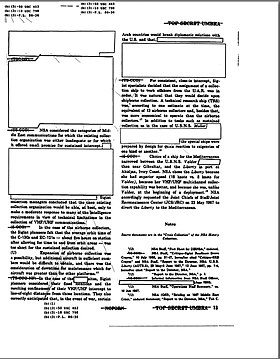
The Freedom of Information Act (FOIA), 5 U.S.C. § 552, is the U.S. federal freedom of information law that requires the full or partial disclosure of previously unreleased information and documents controlled by the United States government upon request. The act defines agency records subject to disclosure, outlines mandatory disclosure procedures, and includes nine exemptions that define categories of information not subject to disclosure. The act was intended to make U.S. government agencies' functions more transparent so that the American public could more easily identify problems in government functioning and put pressure on Congress, agency officials, and the president to address them. The FOIA has been changed repeatedly by both the legislative and executive branches.

Declassification is the process of ceasing a protective classification, often under the principle of freedom of information. Procedures for declassification vary by country. Papers may be withheld without being classified as secret, and eventually made available.
Executive Order 12958 created new standards for the process of identifying and protecting classified information, and led to an unprecedented effort to declassify millions of pages from the U.S. diplomatic and national security history. In 1995, United States President Bill Clinton signed this Executive Order.

Executive Order 13233 limited access to the records of former United States Presidents to a higher degree than the previous Order 12667, which it superseded. It was drafted by then White House Counsel Alberto Gonzales and issued by George W. Bush on November 1, 2001. Section 13 of Order 13233 revoked Executive Order 12667 which was issued by Ronald Reagan on January 18, 1989.
The Commission on Protecting and Reducing Government Secrecy, also called the Moynihan Commission, after its chairman, U.S. Senator Daniel Patrick Moynihan, was a bipartisan statutory commission in the United States. It was created under Title IX of the Foreign Relations Authorization Act for Fiscal Years 1994 and 1995 to conduct "an investigation into all matters in any way related to any legislation, executive order, regulation, practice, or procedure relating to classified information or granting security clearances" and to submit a final report with recommendations. The Commission's investigation of government secrecy was the first authorized by statute since the Wright Commission on Government Security issued its report in 1957.

The Information Security Oversight Office (ISOO) is responsible to the President for policy and oversight of the government-wide security classification system and the National Industrial Security Program in the United States. The ISOO is a component of the National Archives and Records Administration (NARA) and receives policy and program guidance from the National Security Council (NSC).
Leandro Aragoncillo y Aparente is a former FBI intelligence analyst and a retired United States Marine Corps Gunnery Sergeant who was convicted of spying against the United States Government in 2007. A naturalized Filipino-American, he was charged with espionage and with leaking classified information to the regime of a former Filipino president.
The United States government classification system is established under Executive Order 13526, the latest in a long series of executive orders on the topic beginning in 1951. Issued by President Barack Obama in 2009, Executive Order 13526 replaced earlier executive orders on the topic and modified the regulations codified to 32 C.F.R. 2001. It lays out the system of classification, declassification, and handling of national security information generated by the U.S. government and its employees and contractors, as well as information received from other governments.
Special access programs (SAPs) in the U.S. Federal Government are security protocols that provide highly classified information with safeguards and access restrictions that exceed those for regular (collateral) classified information. SAPs can range from black projects to routine but especially-sensitive operations, such as COMSEC maintenance or presidential transportation support. In addition to collateral controls, an SAP may impose more stringent investigative or adjudicative requirements, specialized nondisclosure agreements, special terminology or markings, exclusion from standard contract investigations (carve-outs), and centralized billet systems. Within the Department of Defense, SAP is better known as "SAR" by the mandatory Special Access Required (SAR) markings.
The withdrawal of previously declassified U.S. federal records is a process in which agencies can remove records from public access that they believe were incorrectly declassified and made available to the public at the National Archives and Records Administration. The process is often referred to as "reclassification," but because the records were never properly declassified and remained classified even when made publicly available, they are not re-classified.

Executive Order 13087 was signed by U.S. President Bill Clinton on May 28, 1998, amending Executive Order 11478 to prohibit discrimination based on sexual orientation in the competitive service of the federal civilian workforce. The order also applies to employees of the government of the District of Columbia, and the United States Postal Service. However, it does not apply to positions and agencies in the excepted service, such as the Central Intelligence Agency, National Security Agency, and the Federal Bureau of Investigation.
The Presidential Records Act (PRA) of 1978, 44 U.S.C. §§ 2201–2209, is an Act of the United States Congress governing the official records of Presidents and Vice Presidents created or received after January 20, 1981, and mandating the preservation of all presidential records. Enacted November 4, 1978, the PRA changed the legal ownership of the President's official records from private to public, and established a new statutory structure under which Presidents must manage their records. The PRA was amended in 2014, to include the prohibition of sending electronic records through non-official accounts unless an official account is copied on the transmission, or a copy is forwarded to an official account shortly after creation.
The Interagency Security Classification Appeals Panel, or "ISCAP", provides the public and users of the classification system with a forum for further review of classification decisions. ISCAP states in order to foster a well-informed public while simultaneously protecting national security interests, checks and balances are needed over the classification system. This requires that some of the work of the U.S. Government be done outside the purview of its citizenry.
The Public Interest Declassification Board (PIDB) is an advisory committee established by the United States Congress with the official mandate of promoting the fullest possible public access to a thorough, accurate, and reliable documentary record of significant U.S. national security decisions and activities. The Board is composed of nine individuals: five appointed by the President of the United States and one each appointed by the Speaker of the House, House Minority Leader, Senate Majority Leader, and Senate Minority Leader. Appointees must be U.S. citizens preeminent in the fields of history, national security, foreign policy, intelligence policy, social science, law, or archives.
The Joint Staff Information Management Division (IMD) is one of two divisions which make up the Joint Staff Secretariat (SJS) of the United States Joint Chiefs of Staff currently located in the Pentagon in Arlington, Virginia (USA). The other division is called Actions Division (AD) which manages the daily workflow of the staff.

The Classified Information Procedures Act or CIPA is codified as the third appendix to Title 18 of the U.S. Code, the title concerning crimes and criminal procedures. The U.S. Code citation is 18 U.S.C. App. III. Sections 1-16.
Executive Order 13526 was issued on December 29, 2009, by United States President Barack Obama. It is one of a series of executive orders from US Presidents outlining how classified information should be handled. It revokes and replaces the previous Executive Orders in effect for this, which were EO 12958 (text) and EO 13292 (text).
The Worker Protection Standard is intended to protect employees on farms, forests, nurseries, and greenhouses that are occupationally exposed to agricultural pesticides.

The Presidential and Federal Records Act Amendments of 2014 is a United States federal statute which amended the Presidential Records Act and Federal Records Act. Introduced as H.R. 1233, it was signed into law by President Barack Obama on November 26, 2014.






